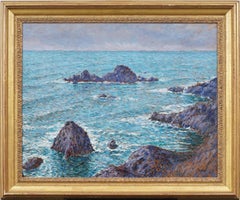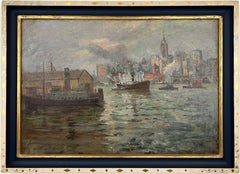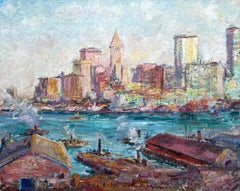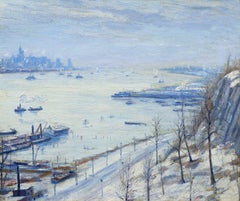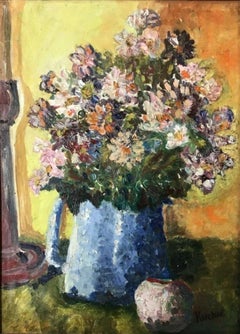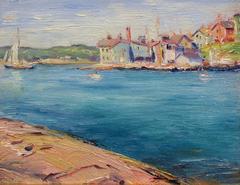Max Kuehne Art
American, 1880-1968
Born in Halle, Germany in 1880, Max Kuehne was a colorist who created cheerful landscapes that appear to be painted spontaneously and with freshness.
He studied with William Merritt Chase and Kenneth Hayes at the Chase School in New York. In 1910, he embarked on a bicycling trip, traveling through England, France, Germany, Holland and Belgium. To support this trip he did portrait commissions along the way.
When he returned to New York City, he set up a studio in Greenwich Village and was a student of Robert Henri from whom he learned a dark impressionist style. He also became close with such avant garde artists as Guy Pene du Bois, William Glackens, William Zorach and Maurice and Charles Prendergast, which also influenced his dark work including street scenes and docks in New York City. However, three years in Spain, and painting trips to Gloucester lightened his palette as did time in Paris where he was much influenced by the Fauves, Nabis, and decorative painters. By 1912 he was producing work that would make him known as a "colourist of great distinction" by producing "paintings full of sparkling sunlight."
He became a member of the artistic community later in Rockport, Massachusetts, with Gifford Beal, Leon Kroll, Paul Manship, Edward Hopper and Jonas Lie. Many of his finest paintings done later in his career are of the busy harbors and piers of Gloucester and Rockport.
His work was widely exhibited including the National Academy of Design, the Art Institute of Chicago, and the Carnegie Institute in Pittsburgh.to
1
2
1
1
2
Overall Width
to
Overall Height
to
6
2
1
1
4
1
6
2
1
1
1
6
5
3
3
2
11
10,083
2,775
1,380
1,375
6
6
Artist: Max Kuehne
Antique American Impressionist Summer Seascape Signed Framed Large Oil Painting
By Max Kuehne
Located in Buffalo, NY
Antique American impressionist Max Kuehne (1880 - 1968) seascape oil painting. Oil on board. Framed. Signed. In excellent original condition. Handsomely framed in a giltwood mol...
Category
1950s Impressionist Max Kuehne Art
Materials
Oil, Board
Provincetown
By Max Kuehne
Located in Milford, NH
A colorful impressionist coastal oil painting of Provincetown by German / American artist Max Kuehne (1880-1968). Kuehne was born in Halle, Germany, and emigrated to Flushing, New Y...
Category
Mid-20th Century American Impressionist Max Kuehne Art
Materials
Oil, Panel
$5,900
Brooklyn Bridge through the Clouds-Original New York 20th Century Oil Painting
By Max Kuehne
Located in Marco Island, FL
An atmospheric and impressionistic view of New York City's towering skyline with ships in the harbour on a misty day. This lovely painting is housed in a beautifully detailed artist...
Category
Early 20th Century American Impressionist Max Kuehne Art
Materials
Canvas, Oil
“View of Lower New York from Brooklyn”
By Max Kuehne
Located in Southampton, NY
Original oil on linen painting laid down to original fiberboard by the well know American artist, Max Kuehne. Signed in pencil verso upper left. Circa 1928. Condition is very good. ...
Category
1920s Abstract Impressionist Max Kuehne Art
Materials
Canvas, Oil, Fiberboard
"Train Station, " Max Kuehne, Industrial City Scene, American Impressionism
By Max Kuehne
Located in New York, NY
Max Kuehne (1880 - 1968)
Train Station, circa 1910
Watercolor on paper
8 1/4 x 10 1/4 inches
Signed lower right
Provenance:
Private Collection, Illinois
Max Kuehne was born in Halle, Germany on November 7, 1880. During his adolescence the family immigrated to America and settled in Flushing, New York. As a young man, Max was active in rowing events, bicycle racing, swimming and sailing. After experimenting with various occupations, Kuehne decided to study art, which led him to William Merritt Chase's famous school in New York; he was trained by Chase himself, then by Kenneth Hayes Miller. Chase was at the peak of his career, and his portraits were especially in demand. Kuehne would have profited from Chase's invaluable lessons in technique, as well as his inspirational personality. Miller, only four years older than Kuehne, was another of the many artists to benefit from Chase's teachings. Even though Miller still would have been under the spell of Chase upon Kuehne's arrival, he was already experimenting with an aestheticism that went beyond Chase's realism and virtuosity of the brush. Later Miller developed a style dependent upon volumetric figures that recall Italian Renaissance prototypes.
Kuehne moved from Miller to Robert Henri in 1909. Rockwell Kent, who also studied under Chase, Miller, and Henri, expressed what he felt were their respective contributions: "As Chase had taught us to use our eyes, and Henri to enlist our hearts, Miller called on us to use our heads." (Rockwell Kent, It's Me O Lord: The Autobiography of Rockwell Kent. New York: Dodd, Mead and Co., 1955, p. 83). Henri prompted Kuehne to search out the unvarnished realities of urban living; a notable portion of Henri's stylistic formula was incorporated into his work.
Having received such a thorough foundation in art, Kuehne spent a year in Europe's major art museums to study techniques of the old masters. His son Richard named Ernest Lawson as one of Max Kuehne's European traveling companions. In 1911 Kuehne moved to New York where he maintained a studio and painted everyday scenes around him, using the rather Manet-like, dark palette of Henri.
A trip to Gloucester during the following summer engendered a brighter palette. In the words of Gallatin (1924, p. 60), during that summer Kuehne "executed some of his most successful pictures, paintings full of sunlight . . . revealing the fact that he was becoming a colorist of considerable distinction." Kuehne was away in England the year of the Armory Show (1913), where he worked on powerful, painterly seascapes on the rocky shores of Cornwall. Possibly inspired by Henri - who had discovered Madrid in 1900 then took classes there in 1906, 1908 and 1912 - Kuehne visited Spain in 1914; in all, he would spend three years there, maintaining a studio in Granada. He developed his own impressionism and a greater simplicity while in Spain, under the influence of the brilliant Mediterranean light. George Bellows convinced Kuehne to spend the summer of 1919 in Rockport, Maine (near Camden). The influence of Bellows was more than casual; he would have intensified Kuehne's commitment to paint life "in the raw" around him.
After another brief trip to Spain in 1920, Kuehne went to the other Rockport (Cape Ann, Massachusetts) where he was accepted as a member of the vigorous art colony, spearheaded by Aldro T. Hibbard. Rockport's picturesque ambiance fulfilled the needs of an artist-sailor: as a writer in the Gloucester Daily Times explained, "Max Kuehne came to Rockport to paint, but he stayed to sail." The 1920s was a boom decade for Cape Ann, as it was for the rest of the nation. Kuehne's studio in Rockport was formerly occupied by Jonas Lie.
Kuehne spent the summer of 1923 in Paris, where in July, André Breton started a brawl as the curtain went up on a play by his rival Tristan Tzara; the event signified the demise of the Dada movement. Kuehne could not relate to this avant-garde art but was apparently influenced by more traditional painters — the Fauves, Nabis, and painters such as Bonnard. Gallatin perceived a looser handling and more brilliant color in the pictures Kuehne brought back to the States in the fall. In 1926, Kuehne won the First Honorable Mention at the Carnegie Institute, and he re-exhibited there, for example, in 1937 (Before the Wind). Besides painting, Kuehne did sculpture, decorative screens, and furniture work with carved and gilded molding. In addition, he designed and carved his own frames, and John Taylor Adams encouraged Kuehne to execute etchings. Through his talents in all these media he was able to survive the Depression, and during the 1940s and 1950s these activities almost eclipsed his easel painting. In later years, Kuehne's landscapes and still-lifes show the influence of Cézanne and Bonnard, and his style changed radically.
Max Kuehne died in 1968. He exhibited his work at the National Academy of Design, the Art Institute of Chicago, the Carnegie Institute in Pittsburgh, the Memorial Art Gallery of the University of Rochester, and in various New York City galleries. Kuehne's works are in the following public collections: the Detroit Institute of Arts (Marine Headland), the Whitney Museum (Diamond Hill...
Category
1910s American Impressionist Max Kuehne Art
Materials
Paper, Watercolor
Water View of New York, 1911
By Max Kuehne
Located in New York, NY
In his oil painting, “Water View of New York, 1911,” Max Kuehne paints the Hudson river from a vantage point atop the palisades. The New York skyline ris...
Category
1910s Max Kuehne Art
Materials
Canvas, Oil
Related Items
"Mt. Evans and Bierstadt, Colorado" Oil Painting
Located in Denver, CO
David Shingler's (NC based) "Mt. Evans and Bierstadt, Colorado" is an oil painting that depicts a green grassy plain dotted with Pine trees leading to the snow capped mountains in th...
Category
2010s American Impressionist Max Kuehne Art
Materials
Oil, Wood Panel
River Spain Spanish landscape oil on board painting
Located in Sitges, Barcelona
Technical Details
Artist: Rosendo González Carbonell
Title: River
Year: c.1980
Technique: Oil on board
Dimensions (without frame): 10.6 x 1...
Category
1980s Impressionist Max Kuehne Art
Materials
Oil, Board
$454 Sale Price
36% Off
H 10.63 in W 11.42 in
Stinchcombe Hill, Rupert Aker, Landscape Painting, Textured Art, Oil Painting
By Rupert Aker
Located in Deddington, GB
Stinchcombe Hill by Rupert Aker [2022]
View along the Cotswold escarpment from Stinchcombe Hill
Additional information:
Original
Oil on board
Image size: H:30 cm x W:30 cm
Complete...
Category
2010s Abstract Impressionist Max Kuehne Art
Materials
Oil, Board
$328
H 13 in W 13 in D 1.19 in
1930s French Impressionist Watercolour of Children in an Idyllic Country Scene
Located in Cotignac, FR
French Impressionist watercolour on paper view of children in an idyllic country scene by Henri Clamen. Signed bottom right. Acquired from the atelier of the artist with other signed works. Pencil annotation top right and to the back of the paper.
A charming view of two children waiting in the shade of a beautiful summers day by the side of a country lane. An archway through to a farmyard and a farmhouse beyond. Dappled light through the overhead leaves and branches. In the lane to the left a hay wain...
Category
Early 20th Century Impressionist Max Kuehne Art
Materials
Paper, Ink, Watercolor
$334 Sale Price
36% Off
H 9.06 in W 5.52 in
Mallorca oil on cardboard painting impressionism spanish seascape
By Joaquin Terruella Matilla
Located in Sitges, Barcelona
Joaquin Terruella Matilla (1891-1957) - Landscape - Oil cardboard
Oil measures 10x14 cm.
Frame measures 20x25 cm.
Joaquim Terruella Matilla (1891 - 1957)
Joaquim Terruella Matilla,...
Category
1920s Impressionist Max Kuehne Art
Materials
Cardboard, Oil
$430 Sale Price
55% Off
H 3.94 in W 5.52 in
Ebbing Tide, Abstract Seascape, Original Landscape Painting, Framed Artwork
Located in Deddington, GB
Ebbing tide is an original landscape painting by Stephen KInder. This painting was completed on location in the late summer of 2019. The painting was completed on West Wittering...
Category
21st Century and Contemporary Abstract Impressionist Max Kuehne Art
Materials
Oil, Board
$806
H 13.78 in W 17.72 in D 1.19 in
"As you Wish" Oil Painting
Located in Denver, CO
Clyde Steadman's "As you Wish" is an original, handmade oil painting that depicts an impasto painting of a bison in profile.
Category
2010s American Impressionist Max Kuehne Art
Materials
Oil, Panel
Charles Partridge Adams California Coastal Watercolor, American Impressionist
By Charles Partridge Adams
Located in Denver, CO
This exquisite California coastal watercolor by American Impressionist Charles Partridge Adams (1858–1942) captures the serene beauty of the shoreline in vibrant hues of blue, green,...
Category
1920s American Impressionist Max Kuehne Art
Materials
Watercolor
$1,495
H 12.25 in W 15.25 in D 2.5 in
Oil Painting of River Bank with Silver Birch Trees and Misty Hills & Mountains
By Charles Wyatt Warren
Located in Preston, GB
Oil Painting of River Bank with Silver Birch Trees and Misty Hills & Mountains by British Artist Charles Wyatt Warren (1908-1993)
Art measures 35...
Category
Late 20th Century Abstract Impressionist Max Kuehne Art
Materials
Oil, Board
$8,131
H 29 in W 41 in D 3 in
"Eastern Plains of Colorado" By Sparky LeBold, Colorado Landscape Oil Painting
Located in Denver, CO
"Eastern Plains of Colorado" by Sparky LeBold (US and Portugal based) is a beautiful handmade oil painting that depicts a view of the vast green plains of Colorado, with the famed su...
Category
2010s American Impressionist Max Kuehne Art
Materials
Oil, Panel
Old House, Built in 1848
By Gilbert Neumann
Located in Austin, TX
"Old House, Built in 1848" by painter Gilbert F. Neumann
Medium: Oil paint on panel
Size: 9 x 12 inches
Frame Size: 14 x 18.5 inches
A nostalgic painting of ...
Category
20th Century American Impressionist Max Kuehne Art
Materials
Oil, Panel
Signal distortion #2 Hélène Duclos 21st Century painting landscape cream art
By Hélène Duclos
Located in Paris, FR
This painting is part of the current exhibition entitled "The fantastic story of the liquid mountain" at Claire Corcia Gallery in Paris.
The liquid mountain is populated by living b...
Category
2010s Contemporary Max Kuehne Art
Materials
Canvas, Oil
$4,662
H 28.75 in W 36.23 in D 1.97 in
Previously Available Items
"Floral Still Life in a Blue Vase" American Impressionist
By Max Kuehne
Located in New York, NY
Max Kuehne (1880 - 1968)
Floral Still Life
Oil on board
16 x 12 inches
Signed lower right: Kuehne
Provenance:
Wilma and Ronald J. Baird, Philadelphia
Private Collection, Rhode Island
Exhibited:
Philadelphia, Mann Center for Older People, May 1968.
Germantown, Pennsylvania, Young Women's Christian Association, May - June 1973.
Max Kuehne was born in Halle, Germany on November 7, 1880. During his adolescence the family immigrated to America and settled in Flushing, New York. After experimenting with various occupations, Kuehne decided to study art, which led him to William Merritt Chase's famous school in New York; he was trained by Chase himself, then by Kenneth Hayes Miller. Chase was at the peak of his career, and his portraits were especially in demand. Kuehne would have profited from Chase's invaluable lessons in technique, as well as his inspirational personality. Miller, only four years older than Kuehne, was another of the many artists to benefit from Chase's teachings. Even though Miller still would have been under the spell of Chase upon Kuehne's arrival, he was already experimenting with an aestheticism that went beyond Chase's realism and virtuosity of the brush. Later Miller developed a style dependent upon volumetric figures that recall Italian Renaissance prototypes.
Kuehne moved from Miller to Robert Henri in 1909. Rockwell Kent, who also studied under Chase, Miller, and Henri, expressed what he felt were their respective contributions: "As Chase had taught us to use our eyes, and Henri to enlist our hearts, Miller called on us to use our heads." Henri prompted Kuehne to search out the unvarnished realities of urban living; a notable portion of Henri's stylistic formula was incorporated into his work.
Having received such a thorough foundation in art, Kuehne spent a year in Europe's major art museums to study techniques of the old masters. His son Richard named Ernest Lawson as one of Max Kuehne's European traveling companions. In 1911 Kuehne moved to New York where he maintained a studio and painted everyday scenes around him, using the rather Manet-like, dark palette of Henri. He also became close with such avant garde artists as Guy Pene du Bois, William Glackens, William Zorach and Maurice and Charles Prendergast, which also influenced his dark work including street scenes and docks in New York City.
A trip to Gloucester during the following summer engendered a brighter palette. In the words of Gallatin, during that summer Kuehne "executed some of his most successful pictures, paintings full of sunlight . . . revealing the fact that he was becoming a colorist of considerable distinction." Kuehne was away in England the year of the Armory Show (1913), where he worked on powerful, painterly seascapes on the rocky shores of Cornwall. Possibly inspired by Henri - who had discovered Madrid in 1900 then took classes there in 1906, 1908 and 1912 - Kuehne visited Spain in 1914; in all, he would spend three years there, maintaining a studio in Granada. He developed his own impressionism and a greater simplicity while in Spain, under the influence of the brilliant Mediterranean light. George Bellows convinced Kuehne to spend the summer of 1919 in Rockport, Maine (near Camden). The influence of Bellows was more than casual; he would have intensified Kuehne's commitment to paint life "in the raw" around him.
After another brief trip to Spain in 1920, Kuehne went to the other Rockport (Cape Ann, Massachusetts) where he was accepted as a member of the vigorous art colony, spearheaded by Aldro T. Hibbard. Rockport's picturesque ambiance fulfilled the needs of an artist-sailor: as a writer in the Gloucester Daily Times explained, "Max Kuehne came to Rockport to paint, but he stayed to sail." The 1920s was a boom decade for Cape Ann, as it was for the rest of the nation. Kuehne's studio in Rockport was formerly occupied by Jonas Lie. He became a member of the artistic community later in Rockport, Massachusetts, with Gifford Beal, Leon Kroll, Paul Manship, Edward Hopper and Jonas Lie. Many of his finest paintings done later in his career are of the busy harbors and piers of Gloucester and Rockport.
Kuehne spent the summer of 1923 in Paris, where in July, André Breton started a brawl as the curtain went up on a play by his rival Tristan Tzara; the event signified the demise of the Dada movement. Kuehne could not relate to this avant-garde art but was apparently influenced by more traditional painters — the Fauves, Nabis, and painters such as Bonnard. Gallatin perceived a looser handling and more brilliant color in the pictures Kuehne brought back to the States in the fall. In 1926, Kuehne won the First Honorable Mention at the Carnegie Institute, and he re-exhibited there, for example, in 1937 (Before the Wind). Besides painting, Kuehne did sculpture, decorative screens, and furniture work with carved and gilded molding. In addition, he designed and carved his own frames, and John Taylor Adams encouraged Kuehne to execute etchings. Through his talents in all these media he was able to survive the Depression, and during the 1940s and 1950s these activities almost eclipsed his easel painting. In later years, Kuehne's landscapes and still-lifes show the influence of Cézanne and Bonnard, and his style changed radically.
Max Kuehne died in 1968. He exhibited his work at the National Academy of Design, the Art Institute of Chicago, the Carnegie Institute in Pittsburgh, the Memorial Art Gallery of the University of Rochester, and in various New York City galleries. Kuehne's works are in the following public collections: the Detroit Institute of Arts (Marine Headland), the Whitney Museum (Diamond Hill...
Category
Mid-20th Century American Impressionist Max Kuehne Art
Materials
Paint, Oil, Board
Sailing Out of Harbor
By Max Kuehne
Located in Wiscasset, ME
Born in Halle, Germany in 1880, artist Max Kuehne studied at William Merritt Chase’s school in New York under Chase, then Kenneth Hayes Miller and in 1909, was a pupil of Robert Henr...
Category
1920s Impressionist Max Kuehne Art
Materials
Oil, Board
A Village Church Near Baya
By Max Kuehne
Located in Fairlawn, OH
Signed by the artist lower right: Kuehne
Signed, dated and titled "A Village Church near Baya (sic)" by the artist in pencil verso.
Category
1920s Max Kuehne Art
Max Kuehne art for sale on 1stDibs.
Find a wide variety of authentic Max Kuehne art available for sale on 1stDibs. You can also browse by medium to find art by Max Kuehne in paint, oil paint, canvas and more. Much of the original work by this artist or collective was created during the 20th century and is mostly associated with the Impressionist style. Not every interior allows for large Max Kuehne art, so small editions measuring 16 inches across are available. Customers who are interested in this artist might also find the work of Donald Teague, William Lester Stevens, and Gifford Beal. Max Kuehne art prices can differ depending upon medium, time period and other attributes. On 1stDibs, the price for these items starts at $2,800 and tops out at $65,000, while the average work can sell for $5,900.
